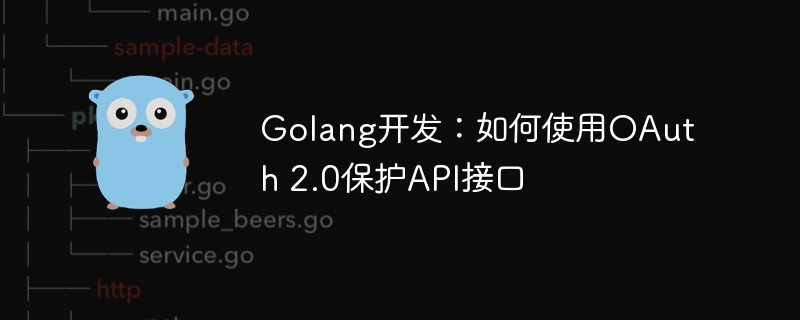Home >Backend Development >Golang >Golang development: How to use OAuth 2.0 to protect API interfaces
Golang development: How to use OAuth 2.0 to protect API interfaces
- WBOYWBOYWBOYWBOYWBOYWBOYWBOYWBOYWBOYWBOYWBOYWBOYWBOriginal
- 2023-09-20 14:55:471308browse

Golang development: How to use OAuth 2.0 to secure API interfaces
Overview:
In modern application development, protecting the security of API interfaces is crucial. OAuth 2.0 is a commonly used authorization protocol used to secure API interfaces and has popular support. This article will introduce how to use OAuth 2.0 to protect API interfaces in Golang development, and provide specific code examples.
OAuth 2.0 Introduction:
OAuth 2.0 is an open authorization protocol for accessing protected resources. It uses tokens to authorize access to resources instead of using username and password directly. OAuth 2.0 adopts a client-oriented design pattern that is particularly suitable for the development of web applications and mobile applications.
Implementation steps:
Here are the general steps for securing an API interface using OAuth 2.0:
- Register the application:
First, you need to register with the OAuth provider your application and get the client ID and client secret. Depending on which OAuth provider you use, the steps to register your application vary. - Configure OAuth client:
In Golang, you can use some popular OAuth libraries to implement OAuth client. For example, goth is a popular Golang OAuth library that provides support for multiple OAuth providers, including Google, Facebook, and GitHub.
First, you need to install the required libraries using goth. You can install goth using the following command:
go get github.com/markbates/goth
Then you need to import the goth library in your application and configure the OAuth provider. For example, for the Google OAuth provider, you can follow these steps to configure it:
import (
"github.com/markbates/goth"
"github.com/markbates/goth/providers/google"
)
func init() {
goth.UseProviders(
google.New(
"YOUR_CLIENT_ID",
"YOUR_CLIENT_SECRET",
"YOUR_CALLBACK_URL",
),
)
}In the above code, you need to replace "YOUR_CLIENT_ID", "YOUR_CLIENT_SECRET" and "YOUR_CALLBACK_URL" with the values you have in the Google Developer Console actual value obtained.
- Implement the authorization process:
Next, you need to implement the authorization process. In Golang, you can use the goth library to simplify the implementation of the authorization process.
The following is an example of a basic authorization process:
package main
import (
"net/http"
"github.com/markbates/goth/gothic"
)
func main() {
// 在某个URL上启动授权流程
http.HandleFunc("/auth", func(res http.ResponseWriter, req *http.Request) {
gothic.BeginAuthHandler(res, req)
})
// 处理授权回调
http.HandleFunc("/auth/callback", func(res http.ResponseWriter, req *http.Request) {
user, err := gothic.CompleteUserAuth(res, req)
if err != nil {
// 处理错误
return
}
// 用户已通过授权
// 在这里实现您的业务逻辑
})
// 启动服务器
http.ListenAndServe(":8000", nil)
}In the above code, we start the authorization process on the "/auth" URL and call it on the "/auth/callback "Handle authorization callback on URL. By calling the CompleteUserAuth function, you can obtain the authorized user's information and implement business logic related to the authorized user in the processing callback function.
- Protect API Interface:
Finally, you need to protect your API interface so that only authorized users can access it.
The following is a simple sample code to protect your API interface:
package main
import (
"fmt"
"net/http"
"github.com/markbates/goth/gothic"
)
func main() {
// ...
// API接口处理函数
http.HandleFunc("/api", func(res http.ResponseWriter, req *http.Request) {
// 检查用户是否已通过授权
if gothic.GetAuthURL(res, req) == "" {
// 用户已通过授权
// 在这里实现您的API逻辑
} else {
// 用户未通过授权
http.Error(res, "Unauthorized", http.StatusUnauthorized)
}
})
// ...
}In the above code, we check whether the user has been authorized before processing the API request. If the user is not authorized, an HTTP 401 - Unauthorized error is returned.
Summary:
In this article, we introduced how to use OAuth 2.0 to protect API interfaces in Golang development and provided detailed code examples. By following the steps above, you can secure your API and restrict access to only authorized users.
The above is the detailed content of Golang development: How to use OAuth 2.0 to protect API interfaces. For more information, please follow other related articles on the PHP Chinese website!

